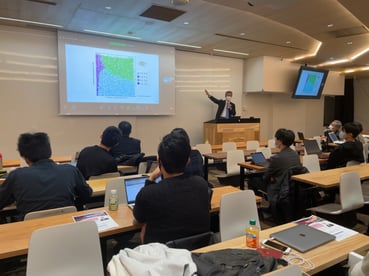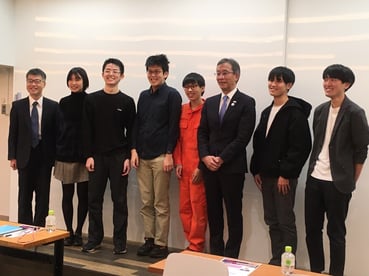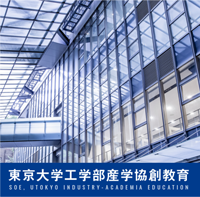Report on the 2nd Special Lecture
November 16, 2022
Special Lecture
The workshops for Tech Ambassadors of the Metaverse School of Engineering have been expanded as a series of Special Lectures that can be attended and viewed by faculty, staff, current students, and participants in reskilling courses. The second lecture was given by Dr. Teruo Fujii, President of the University of Tokyo, on "Technology Beyond the Realm.
Content of Lecture
Lecture: Teruo Fujii, President, The University of Tokyo
Title: Technology Beyond the Realm - Dear Tech Ambassadors of the Metaverse School of Engineering
I originally graduated from the Department of Naval Engineering in the Faculty of Engineering with a degree in technology for building ships and offshore oil rigs for oil drilling. After completing graduate school, I worked at the Institute of Industrial Science and Technology (IIST) and RIKEN, became a professor and then the director of the IIST, and later served as the university's executive officer and vice president, director, and vice president before assuming the position of president last year.
My research, which began in naval engineering, has crossed over many domains, eventually becoming Applied Microfluidics Systems, which create a wet system on a device to make it react, or to cultivate cells to study the efficacy of a drug.
This is also related to research on the deep-sea environment, and recently I have been working on artificial reaction systems that combine DNA and enzymes to create neural networks and use molecules to process information. I would like to talk about how I have strayed so far from naval engineering.
When I was an undergraduate student in 1985, underwater robots (now called underwater drones) were being realized. How to control and operate such autonomous underwater robots was a major challenge.
For example, how to make them swim in a straight line? If you write the equations of motion, they become extremely complex and nonlinear. If you change the configuration even slightly, you have to start all over again. It was a daunting process of conducting tank experiments, identifying parameters, and designing the control system each time.
So I made a model of a neural circuit and created a simple neural network system in which the robot gradually became better and better at swimming. At first it flops around akwardly, but gradually it builds a model of the characteristics of its own locomotion, tunes the control system, and becomes able to swim properly. This model of locomotion is called a "recurrent network" and is very commonly used in current deep learning.
This is the very prototype of today's AI. At that time, it took about two weeks of computation on a 16-bit computer, and before you knew it, the data had diverged and the computation had stopped, but nowadays, this capacity has expanded exponentially, making it possible to perform extremely high-speed computation and collect large amounts of data. This development itself is making AI truly usable.

The lecture by President Fujii
After that, I started research on microfluidics, a completely new theme at RIKEN. At the time, the idea was to create "micromachines," small vehicles that were like extensions of undersea robots that could be placed inside the body. However, it is not really easy to make a robot small and still cause big mechanical effects.
Rather, we came up with the idea that if we could use microscopic space and utilize it with chemicals, we could expect big effects. By working together with the biology professionals at RIKEN, we could also cross the boundaries of the field.
So we started a research field in which we created a very small space, about 50 microns in diameter, or about half the scale of a hair, and handled liquids in it like a microscopic test tube.
We started by reproducing firefly luminescence by making an enzyme called "luciferase" from firefly genes, and then developed the technology to synthesize proteins from genes without using cells. As we make the volume smaller and smaller, we can make a very dense protein array, a collection of purely encoded proteins from a single piece of DNA. So in controlling the reaction, we started to map out how the reaction would be when mixed together to see the whole picture.
We make mixtures of different ratios in about 10,000 droplets at once. We would put fluorescent labels together to distinguish what concentration of DNA or enzyme was put in each one. After rearranging the measurements of these in the computer in places corresponding to the mixing ratios, we can now identify in a single run how the substance has increased or decreased according to the concentration ratio of one parameter to another. While it would be very difficult to do this experiment one by one, in a microfluidics system with many small test tubes, it is possible to make many droplets at one time and read out various combinations of reaction conditions all at once.
I believe that this will lead to a new type of computing. The term "information explosion" has been used for about 10 years now, and we need to keep building data centers. However, if it is silicon-based, it will become physically impossible around 2050. With DNA, one kilogram of DNA has a data density of zettabytes, which can computationally contain the data of the entire Internet. DNA is a very stable molecule, so it may be an effective candidate for information storage that can be kept for 100 years or so.
I want to tell you all that we do not know what the future holds for the various things we are currently working on. The thing is that if you think carefully from the perspective of what you are doing now, you will be able to make use of it as a perspective that no one else has when you face a completely different challenge in the future. Therefore, I believe that taking on new challenges and new areas will lead to the creation of the society of the future.
I have been in many different fields, and I would like to end this talk by saying that I hope that you will use this experience as a source of inspiration and enjoy it as you venture out into different fields in the future.
Report
 Tech Ambassadors and Takao Someya, Dean of the Graduate School of Engineering With President Teruo Fujii
Tech Ambassadors and Takao Someya, Dean of the Graduate School of Engineering With President Teruo Fujii
For the second special lecture of the Metaverse School of Engineering, we were honored to have the President of the University of Tokyo, Dr. Teruo Fujii, as our guest speaker. The lecture was held in Room 51, Building No. 5 of the Department of Engineering, which has undergone renovation. This is off topic, but it is a very nice classroom with wood cut from the University of Tokyo Experiment Forest.
There were 23 participants on-site and 98 participants online. More than half of the participants were from outside the university, including participants of the reskilling courses.
As mentioned above, he introduced the history of his research, which started with ocean exploration robots during his graduate school days and progressed to microfluidic devices, incorporating and developing other fields of research. Many of the participants must have been amazed at how he captured the concept of microfluidic devices as effective chemical reactions in a microscopic space.
During the Q&A session, there were many questions about how to prepare oneself for venturing into a new field. He experienced firsthand that having new members from different backgrounds come into the research community can have a huge impact on those who welcome them, making it easier for new ideas and solutions to emerge. He was also always conscious of the developmental potential of the research he was working on, and how it could be expanded into other fields in the future.
It has been a long time since it was said that a team consisting of diverse members with different backgrounds produces creative results, but the reality is that many research teams struggle with the fact that diversity is necessary, but diversity for its own sake is not sufficient. One of the most suggestive comments was that the key to the functional success of a research team after bringing in diverse members is to set up "questions" that are "interesting" to all members. I am currently involved in a research team. I would like to stop and review whether I have asked such "questions" in the research team I am currently involved in.
(Written by Akiko Kumada, Assistant Dean of the Graduate School)
Contact us
METAVERSE SCHOOL OF ENGINEERING




